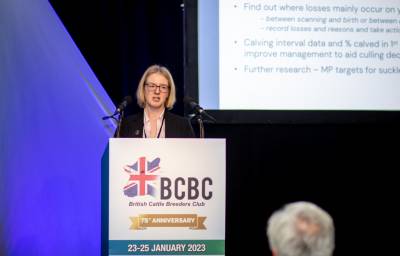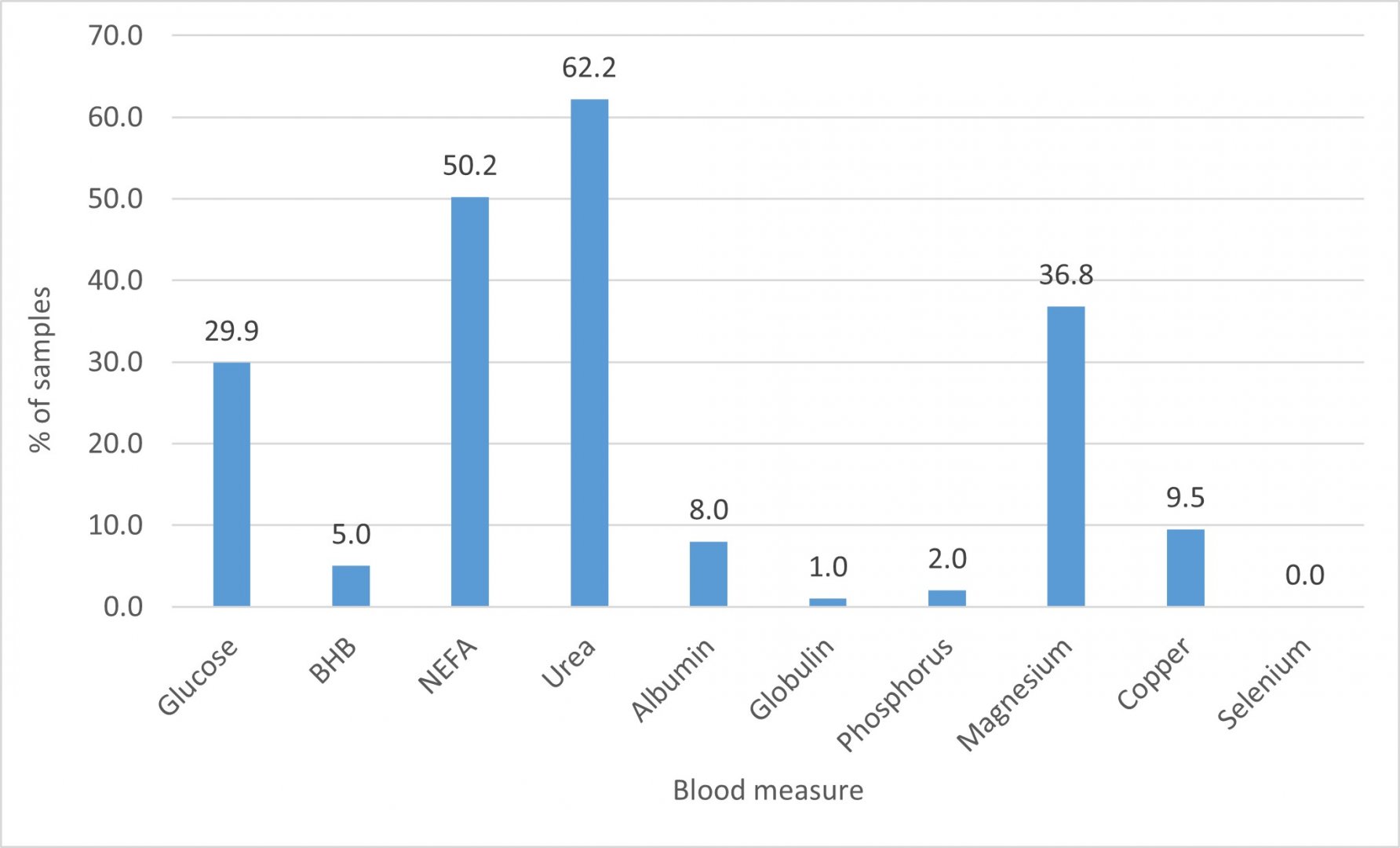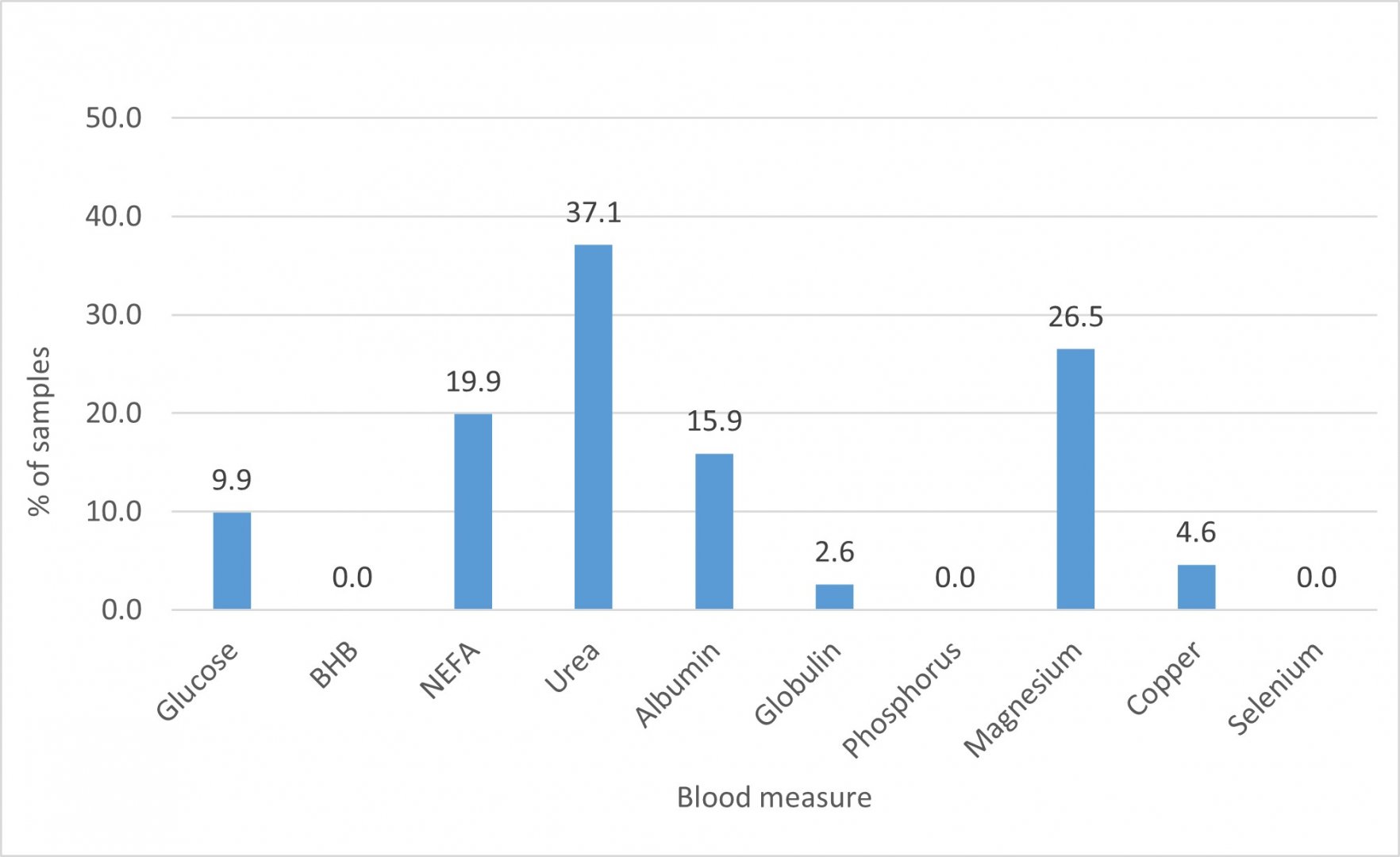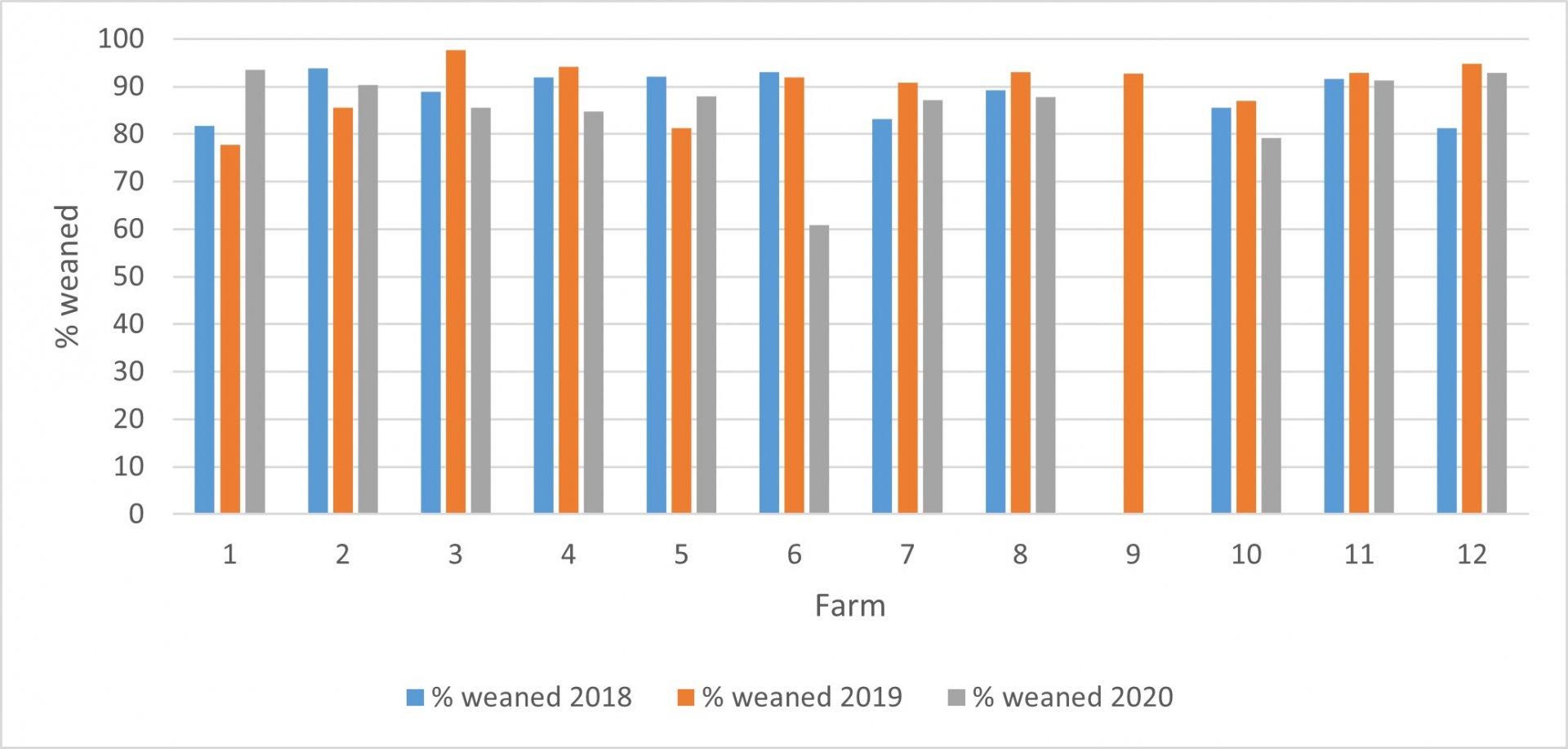
Background
Feeding the suckler cow is one of the largest costs in the beef industry. Existing research suggests that over one third of cows do not calve at the target BCS and are at least half a point away from the guidelines (on a 5-point scale) (Turner et al., 2021). This has implications for calving ease, calf survival and subsequent fertility. Therefore, there is a need to improve feeding management of suckler cows, especially at calving time to ensure that nutritional requirements are met for a successful, trouble-free calving and to protect future fertility.
Metabolic profile (MP) testing is a commonly used tool to assess nutrition in dairy herds but has had little uptake in suckler herds and tends to only be carried out pre-calving. Therefore, post-calving MP tests have not been conducted in Scotland prior to this project. It is a great way to “ask the cows” what they think of their ration and can highlight areas of nutrition where corrections can be made to benefit calving performance, energy status and subsequent fertility. Farmers view nutrition as one of the most crucial factors influencing calving performance and fertility in suckler herds and funding was received from the Scottish Government’s KTIF (Knowledge Transfer and Innovation Fund) scheme to support the investigation into MP tests to assess nutrition over the calving period and how that linked to herd fertility.
Project Aims
The aim of this project was to assess the nutritional status of suckler cows both pre-calving and post-calving and identify whether this information could be linked to subsequent fertility.
The specific objectives were:
- To investigate the nutritional status of suckler cows by using MP testing pre- and post-calving in spring 2020.
- To investigate the relationship between nutrition and subsequent fertility from dietary information and MP test results with pregnancy diagnosis data from the herds in late 2020.
- To determine whether a change in body condition score between the pre- and post-calving period affected cow fertility.
- To use the findings from these commercial suckler herds to produce practical recommendations on feeding management for future calvings to improve both technical and financial efficiency.
Methodology
Twelve suckler producers located in Angus and West Fife (Scotland) were recruited through their veterinary practices in late 2019 in preparation for the 2020 spring calving period. The participating farms were a mix of lowland, upland, and hill farms with a range of breeds from traditional to continental. These farmers were keen to know the nutritional status of their herd through MP testing as none of them had carried this out before.
Fifteen cows in each herd were selected to undergo blood testing approximately one month before calving and one month after calving. The following parameters were tested for, which provided information on protein, energy, health and mineral status:
- Energy status: non-esterified fatty acids, beta-hydroxybutyrate and glucose
- Protein and health status: urea, albumin, and globulin
- Mineral status: magnesium phosphorus, copper, selenium, and iodine
The aim was to select cows for sampling that would be calving at the start of the calving period and relatively close together, so they were as near to being sampled at one month pre-calving. Cows were selected based on when they calved in the last calving period and pregnancy diagnosis results, as some scanners were able to provide information on how far in-calf cows were when scanned. No heifers were included, or cows known to be carrying twins.
The selected 15 cows in each herd were body condition scored by the vet at the same time as blood sampling to determine the extent of body condition loss over the calving period.
Ration details pre- and post-calving were collected along with forage analysis and mineral supplementation information to assess whether the diet met protein, energy, and mineral requirements and this was reviewed in conjunction with the MP test results. Ration analysis was carried out through SAC Consulting’s Feedbyte ration programme.
The effect of nutritional status at calving time on subsequent fertility was investigated through pregnancy diagnosis information in late 2020 to identify how many animals in the herd were pregnant and not in-calf. It was important to determine whether the 15 trial cows in each herd were pregnant and if not, was there a reason that could be identified from the MP tests over the calving period that could explain infertility? The following information was collected when the herds were ultrasound scanned for pregnancy diagnosis:
- Number of cows/heifers scanned
- Number of cows/heifers in calf
- Number of cows/heifers not in calf
- Number of sets of twins
- How many days in calf for each animal (if provided by the scanner)
- Confirmation on whether all 15 trial cows were back in calf
Calving dates in 2020 and historical fertility data were used to calculate key performance indicators to compare against industry benchmarks and provide farmers with recommendations for improvements. The following key performance indicators were benchmarked:
- Percentage of cows calving in the first 3, 6 and 9 weeks of the 2020 calving period.
- Percentage of cows in-calf and percentage of empty cows.
- Percentage of calves weaned per 100 cows put to the bull.
Results and Recommendations
Results
One third of cows were deficient in magnesium pre-calving (see Graph 1 below which indicates the % of cows sampled that had blood parameters out with the target range). This is significant given the impact a lack of magnesium can have on slow calvings and then potentially the health status of the calf (how quickly it stands and suckles colostrum).
One quarter of cows were deficient in magnesium post-calving (see Graph 2 below). Again, this is significant to address, with low magnesium in cows going out to grass exacerbating the risk of grass staggers.
The other parameters that were often out with target levels both pre- and post-calving in the blood were urea (indicating a lack of rumen degradable protein) and non-esterified fatty acids (NEFA’s), indicating a lack of energy in the diet and potential loss of condition. This could result in low colostrum quality and quantity if not corrected. Pre-calving, 50% of cows were struggling with their energy status and 62% of cows were short of dietary protein. Post-calving results were slightly better but there was still evidence of sub-optimal nutrition, with 20% of cows being in poor energy status and 37% of cows deficient in dietary protein.
From reviewing mineral supplementation, many herds were oversupplying minerals. It was extremely rare for any cows to be deficient in the minerals tested for other than magnesium.
Graph 1. The percentage of pre-calving blood samples which had nutritional parameters out with the target range.

Graph 2. The percentage of post-calving blood samples which had nutritional parameters out with the target range.

While on paper the rations may have appeared to meet requirements, the MP tests gave the real picture of how the cows were coping and could therefore point to management factors that might be leading to suboptimal nutritional status (e.g., insufficient feed space, health/fluke issues and ration presentation).
Impact on Fertility
While there were instances where the MP results looked poor, with cows in poor energy status and had lost significant condition, farmers acted on the results to increase energy supply via concentrate feeding or providing access to good grass in preparation for bulling, 95% of trial cows got back in calf (see Table 1). However, it is unknown whether these cows took longer to start cycling after calving and hence got in calf later compared to the rest of their herd mates. This could only be determined based on calving dates in 2021 (which was beyond the timescale of the project). Therefore, the MP tests did not necessarily give a good indicator of future fertility. However, their benefit is that corrective action can be taken that will help improve the number of cows getting back in calf.
Table 1. Pregnancy diagnosis results of the 15 trial cows per farm
|
Farm |
Number of trial cows confirmed back in calf |
Comments |
|
1 |
12 |
Three cows not in calf were all over 10 years of age and had normal blood results post-calving. Pre-calving, only two out of the three had poor energy status results. |
|
2 |
13 |
For the two cows not in calf, one had a caesarean, the other had low albumin/high globulin both pre- and post-calving indicating likelihood of an inflammatory condition. Both cows lost 1.5 BCS units over the calving period. |
|
3 |
15 |
11 cows had high NEFA post-calving and five lost 1 BCS unit over calving period. |
|
4 |
15 |
12/15 cows had high NEFA’s pre-calving but perfect set of energy results post-calving, despite fluke suspected by low albumin in five cows and four cows at BCS 1.5 post-calving. |
|
5 |
13 |
Two cows culled so not put to bull (bad temperament and bad udder). Excellent blood results both pre- and post-calving. |
|
6 |
15 |
Good energy status over calving period but blood urea low in all cows both pre- and post-calving (possible lack of rumen degradable protein?). |
|
7 |
? |
Does not scan. |
|
8 |
15 |
More cows with high NEFA’s pre-calving (9) versus post-calving (4). |
|
9 |
9 |
Five sold and one out of remaining 10 not in calf. 14/15 cows with high NEFA’s pre-calving but no issue post-calving. |
|
10 |
13 |
One cow not in calf and one died pre-scanning. Low blood urea was much more of an issue both pre- and post-calving compared to energy results which were fairly good. |
|
11 |
12 |
Two cows not in calf and one died pre-scanning. Energy status was much poorer pre-calving (12/15 cows with high NEFA’s) versus post-calving (none with high NEFA’s). |
|
12 |
15 |
Low blood urea pre-calving was an issue and post-calving high NEFA’s were seen in the majority of cows. |
When analysing pregnancy diagnosis information and historic herd fertility data it became apparent that the industry targets for herd fertility are difficult to achieve consistently year on year, even by this group of highly capable farmers. Only three of the herds achieved the industry target of less than 5% barren (see Table 2).
Table 2. Whole herd pregnancy diagnosis results for the 12 farms
|
Farm |
% cows scanned in-calf |
% cows scanned barren |
Sets of twins |
Calves/100 cows |
|
1 |
91.5 |
8.5 |
5 |
100 |
|
2 |
91.6 |
8.4 |
5 |
94.8 |
|
3 |
93.7 |
6.3 |
6 |
96.8 |
|
4 |
95.8 |
4.2 |
2 |
97.5 |
|
5 |
97.2 |
2.8 |
4 |
99.4 |
|
6 |
89.4 |
10.6 |
1 |
91.5 |
|
7 |
Does not scan |
- |
- |
- |
|
8 |
92.7 |
7.3 |
2 |
94.3 |
|
9 |
93.2 |
6.8 |
3 |
94.8 |
|
10 |
91.6 |
8.4 |
? |
? |
|
11 |
88.0 |
12.0 |
4 |
92.4 |
|
12 |
95.9 |
4.1 |
0 |
95.9 |
|
Average |
92.8 |
7.2 |
|
95.7 |
Very few farms ever reached the industry target of 94 calves weaned per 100 cows put to the bull (see Graph 3). However, it is important farmers do not get disheartened by not achieving industry targets. Instead, what the farmers took from this project is that some of them need to record and analyse data more thoroughly to identify where improvements can be made and with expert advice, make management practice changes that could improve fertility and reduce calf losses. Keeping accurate records on where calf losses were occurring (i.e., from scanning to birth or from birth to weaning) was also highlighted to help with future breeding decisions.
Graph 3. Percentage of calves weaned/100 cows out to the bull

Conclusions
It was difficult to link MP test results to subsequent fertility, with 95% of trial cows confirmed in-calf. Many cows with poor nutritional status over the calving period still got back in-calf, likely due to farmers taking corrective nutritional action, i.e., increasing concentrate feeding post-calving in cows with poor energy status may have helped prevent further condition loss, increasing their chance of getting pregnant.
MP testing has helped highlight what the key nutritional problems tend to be over the calving period and what farmers and their nutritionists need to focus on. The results also enabled farmers to make changes to nutrition to improve the nutritional status of the herd, which hopefully in turn helped to protect fertility and result in less barren cows. This was a key outcome in that MP tests can be used successfully in the suckler herd to help manage nutrition and improve the outcome for calving and efficient herd fertility. It is also another way to assess health status as liver fluke was detected in two herds (on the back of low blood albumin levels), which might have taken longer to diagnose without the MP tests, resulting in poorer health status that could have adversely affected fertility.
On the back of MP testing, the majority of farmers taking part in the study found something they could alter to help improve future calving performance and herd fertility and expressed interest in continuing with MP testing for future calving periods.
Acknowledgements
This project was jointly managed along with SAC Consulting beef Specialist and Nutritionist, Karen Stewart. We gratefully acknowledge the financial support from the Scottish Government’s Knowledge Transfer and Innovation Fund (KTIF) for this project. Thanks, are also due to Graeme Richardson of Thrums Veterinary Practice in Kirriemuir and Euan McKee of Cameron & Greig Veterinary Practice in Milnathort, for conducting blood sampling and condition scoring on participating farms. The University of Edinburgh was also a key partner, with veterinary expertise from Alastair Macrae at the Royal (Dick) School of Veterinary Studies where the blood samples were analysed through the Dairy Herd Health and Productivity Service. Expert advice was also provided by SRUC researchers Simon Turner and Kenny Rutherford.
Reference
Turner, SP., Rutherford, KMD., Donbavand, JE and Jack, MC. (2021). The impact of body condition in pregnant beef cows for calf welfare and lifetime productivity. Available at: https://pure.sruc.ac.uk/ws/portalfiles/portal/42459485/RB_Turner_et_al_2021_02.pdf (Accessed: 2 December 2022).
Photography Credit @Jenny Wood Photography